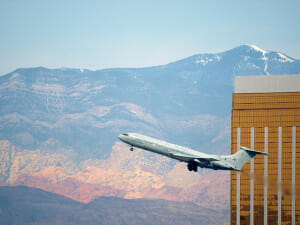What is Las Vegas, Nevada’s Elevation & Does the Altitude Affect Visitors?
By Steve Beauregard
Considering it is smack-dab in desert basin, Las Vegas has a surprisingly higher-than-expected altitude. In fact, the elevation of Las Vegas is just a little less than under ½ mile high, at 2,030 feet above sea level, or 620 meters.
This is an average elevation however, as some areas of the valley are lower (Winchester by the Strip), while in others, the elevation rises as you go to places like Henderson to the south east, and to Mt. Charleston, to the north west.

The fact Las Vegas is nearly ½ mile in elevation surprises many people, especially considering that Las Vegas is a city that is just 135 miles away from the place with the lowest elevation in North America, Death Valley, California, which is 280 feet below sea level.
Las Vegas Elevation Above Sea Level
If that weren’t odd enough, the Las Vegas Strip is about an hour’s drive from a ski area reaching over 11,000 feet above sea level. So in other words, like the town itself, elevations around Las Vegas are full of extremes.
The official elevation of McCarran International Airport is slightly higher than Las Vegas’s altitude. It’s 2,181 feet above sea level at the airport. North Las Vegas has an elevation of 2,205 feet.
Enterprise, Nevada, a suburb to the south and west of Las Vegas is a good 25% higher than Sin City, at 2,552 feet.
The elevation is also slightly higher in nearby Henderson, Nevada, where the town averages 2,402 feet above sea level.
The lowest elevation in the Las Vegas area, by my calculation, is in Winchester, Nevada, an unincorporated area that encompasses part of the Strip, but mostly only around the north Strip area (think Sahara Las Vegas), and the Las Vegas Convention Center.
The elevation here is 1,919 feet above sea level. Oddly enough, just a few feet stroll from Winchester’s northern boundary is the place in Las Vegas with the highest elevation.
Here I’m talking about the Stratosphere.
If you’re on top of the Stratosphere’s tower at the north Las Vegas Strip hotel and casino, you are over 3,000 feet above sea level. The top of the Stratosphere (the part where people can actually go), is 1,000 feet above the ground, and the ground is roughly 2,000 feet above sea level. (The actual top of the Stratosphere is 1,149 feet high, but people cannot access the very top point of the structure of course.)
On a much higher scale, nearby Mt. Charleston, to the west of the Strip, rises 11,916 feet above the Las Vegas valley floor below. In fact, from the center of the Las Vegas Strip, it’s just a one hour drive to the Las Vegas Ski and Snowboard Resort on Mt. Charleston.
Las Vegas Ski and Snowboard Resort’s base area has an elevation of 8,510 feet above sea level, and the resort gets 240 inches of snow a year. The ski area usually opens around Thanksgiving, and closes in April.
How Will the Las Vegas Altitude Affect Me on My Trip?
The short answer is that it won’t. (Says the guy who has lived all his life in Colorado at a mile above sea level).
My understanding is that the 2,000 foot Las Vegas elevation won’t affect the vast majority of people, other than possibly making your hangover a tad bit worse than it would be at sea level.
According to the website, highaltitudemedicine.org, high altitude starts at 4,921 feet (1500 meters), above sea level. So since the elevation of Las Vegas is less than half of that, it is not a major concern. However the usual disclaimers apply, (drink lots of water, wear sunscreen, tip your dealer, etc.).
(Photo courtesy of g Tarded via Flickr).
